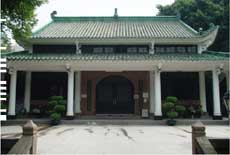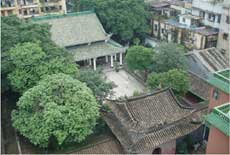 |
| Guangzhou Mosque: one of the entrance halls leading to the main courtyard after the wall to stop evil spirits |
In our Farrukh Travels series, we will follow Farrukh Younus as he travels around the globe. Farrukh is a young British Muslim from a Pakistani background who has to travel a great deal in his work. In this monthly series Farrukh will share his adventures, cultural observations, and spiritual contemplations in his search for that which we share and that which is unique to each place and community.
“All aboard! Raise the anchor! Set the oars! Row, row, row!”
To be honest, I’m not sure whether it went down like that or not. Suffice it to say that of the two routes from Arabia to China—one by land, the other by sea—we know that Sa`d ibn Abi Waqqas, the Prophet Muhammad’s uncle, took the latter.
During the Tang Dynasty, Sa`d led a delegation of the Prophet Muhammad’s Companions to China. Landing in the coastal city of Guangzhou in the southwest of China, they founded the first mosque in the country, Huaisheng Mosque, located on Guangta Street. Roughly translated, huaisheng means “remember the sage,” indicating that it is a memorial mosque for the Prophet Muhammad.
Unfortunately, the mosque was rebuilt during the 14th century and again in the 17th century. Its most recent change was to the prayer hall, which was rebuilt in the 20th century. The mosque complex is built in traditional Chinese style: Upon entry through the front gate one faces a wall in the center which one can pass from the left or from the right. Its function, according to Chinese custom, is to serve as a barrier to keep evil spirits out.
The prayer hall itself is somewhat bland. Having been rebuilt in concrete, it is lacking the character found in many other Chinese mosques, though the external architecture does show a strong Chinese influence.
Guangta Street is extremely congested; thus walking into the mosque complex, leading onto an open courtyard, is quite a refreshing experience. We—my translator Ewa and I—were greeted by a middle-aged Muslim lady who was teaching some children the art of Tai-Chi in the courtyard. I was hoping for more activity given that it was about 10 a.m., but all we encountered were stares from a lady working in the kitchen and some workmen. Construction, everything in China is under construction, but—unlike other countries—they usually finish what they start!
 |
| Guangzhou mosque prayer hall
|
Having fulfilled the sunnah of praying two rak`ahs as a greeting for the mosque, we took some photos of the mosque and its surrounds. For Ewa, a Polish lady studying Chinese yet fluent in English, this was the first visit to any mosque. Intrigued by the mixed Chinese-Islamic architecture, she was happy to be photographed alongside a sign reading “Muslims only” at the entry of the mosque. In Poland, stereotypes about how Muslim women are treated are quite bad and whilse Ewa is not Muslim, e-mailing such a photo to her mother would cause a friendly shock.
The main attraction of the mosque, in my opinion, was the minaret, the Light Tower, one of the earliest examples of Islamic architecture in China. Reaching a height of 36 meters (118 feet), the tower has two entrances at opposite sides and two spiral staircases making their way to the top. In years gone by, the tower was used as a lighthouse guiding ships along the Zhujiang River and indicated the beginning of the maritime Silk Route. While climbing the tower, Ewa dubbed me “Indiana Farrukh”; allow me to explain.
When we reached the base of the tower, we set about finding a way to the balcony atop. One of the entrances was flooded as well as locked; the other, also flooded, had a suspended door held in place with a copper wire—our point of entry. There was only one snag. It was a hot day and we were both wearing slippers, but despite the ruggedness of Birkenstocks, the pool of stagnant water about 6 inches deep with cockroaches and what looked like worms swimming in it didn’t look very inviting. The worms couldn’t have been longer than 2 inches, but we have all heard the story of David and Goliath, and I was not prepared to be struck down by some illness transmitted by that little creature!
I wondered whether my vaccinations were up to date and almost wished they weren’t so I wouldn’t have to step into the water. Having travelled 12,500 miles, I wasn’t intending to allow a little insect-infected water to get in my way.
Stumped, I put on my McGiver hat saying to myself, “Think!” What would McGiver do? Jury-rig a watch into a mechanized harness and pull himself over the water? Take a pair of shoes turning them into 8-inch platforms? I am creative, but I’m certainly not McGiver. Instead we adopted a more solemn approach. We walked to the canteen, took four stools, used them as stepping stones, avoided what looked like a monster worm still alive, wriggling in the water, readying to pounce on unsuspecting visitors. If the mosque management didn’t want visitors climbing the tower, they could easily have installed a burglar alarm. Given my experience, however, the stagnant water with floating insects seemed more effective!
 |
| View from the top of the minaret
|
Having overcome the initial hurdle, we made our way up the tower. In the pitch black with only the flash on my camera to guide us, the walls seemed to narrow in on us, the steps seemed to become more uneven, the insect sounds seemed to— *crunch*—oops! that can’t have been good. Anyone who has seen Indiana Jones and the Temple of Doom—when the hero is going through the secret passage from the bedroom into a room filled with insects—can appreciate what we went through.
Anyway, cutting a long story short—particularly before people start questioning how manly I am—we eventually made it to the top. There I semi-suspended myself over the side to take photos of the mosque complex and to enjoy the view; to imagine, for hundreds of years, a muezzin would climb to this height to call out the invitation to prayer! Up until recent generations, the tower would have been one of, if not the, highest constructions in Guangzhou. What a beautiful sound must have echoed from here! I wanted to make the call to prayer, I wanted to try and relive some of that history, but something about the idea just didn’t seem right. There was a certain calm about the place that I didn’t want to disturb, so I left it at that and we made our way down again.
Now those familiar with the Indiana Jones series will remember an adventurous man, fully capable, creative, responsive, demonstrating no fear, conquering hurdles to reach a goal. For those present that day it was quite clear that Ewa was much more “manly” than I (insert “Tim the toolman Taylor”) and certainly more daring in the tower. The title was more in jest, though I think I’ll have a T-shirt printed along those lines.
As we left the mosque by the entrance, a Chinese Muslim man sat alongside his bicycle repairing it. It crossed my mind that it doesn’t matter where we are in this world, for as people we do the same things that everyone else does, irrespective of faith. Recognizing this commonality that we all share shows to those who take the time to understand that, despite any religious differences, we as a human race are in essence very much the same.
** Farrukh I. Younus holds a masters degree in international business management and works in the emerging telecom industry. He resides in Surrey, UK. His interests include travel, nouvelle cuisine, and chocolate. You can contact him at: farrukh@ntlworld.com.